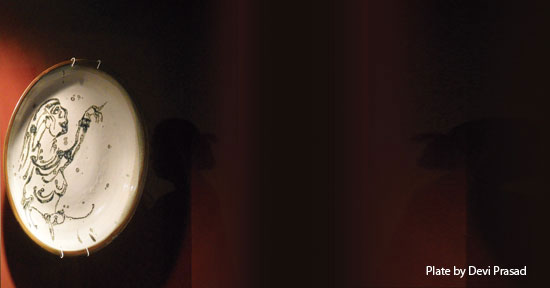It was a pleasure to be able to see the wonderful Devi Prasad exhibit curated by Jawaharlal Nehru University’s Professor Naman Ahuja at the Lalit Kala Akademi in Delhi. Devi Prasad is known as one of the great Indian artist-potters and his ceramic works have been collected and shown previously in India and Britain. However, it was only after I saw the show, that I became aware of the variety and extent of his work. Pots, paintings, photographs, architectural drawings for structures like the one he created for the Indian National Congress’ Jaipur session in 1948, graphic designs, tool designs, writings…the exhibition covered 65 years of his work as an artist-craftsman from 1938 to 2003. I was lucky enough to get a private guided tour by Naman, who is in the middle of writing four books simultaneously and hence a very busy man indeed!
Prasad was an important figure in the arts and crafts movement worldwide, which was a fight against industralisation at the end of the Victorian era. This movement was founded on the cultures of India, Japan and China, but its historical impact, at least in India, has been ignored. Politically, Prasad participated actively in the Quit India Movement in 1942, in Vinoba Bhave’s Bhoodan and later, from 1962 onward, became the Secretary General (and later Chairman) of the War Resisters’ International, the world’s oldest pacifist organisation based in London.
He had quite an incredible creative life which began at Tagore’s Shantiniketan in 1944 and continued at Gandhi’s ashram, Sevagram, where he went to work as an art teacher. There he set up a Kala Bhavan – with a painting studio and pottery and photography workshops, where his commitment to the act of making was obvious, and this commitment extended right back to his source materials. Prasad did absolutely everything himself and also recorded everything he did meticulously. So as a potter he would build his own tools, kiln and wheel and in his subsequent studios, incorporated carpentry, welding and other such workshops. He would also write down precise recipes of clay, temperatures to fire pots, how to make tools, for other potters in his extensive diaries. Another thing which I found very interesting was his insistence on not having a signature style to identify his work. He preferred to play in a particular way and then move on, without attachment.
Naman told me that Prasad’s life might be read as a conflict between Tagore’s ideas of aesthetic beauty and Gandhi’s belief in functionality and practicality. One of the first few works that moved me in the exhibition was a self-portrait that he completed as his final painting in Shantiketan in which the young artist reclines on a bed with a book while watching two lizards. Naman’s account of Gandhi and Tagore’s organisations and their influence on Prasad as well as the many other factors that led to the possibility of his subsequent life such as Coomaraswamy coming back to India and starting printing presses or Gokhale’s own particular kind of activism was so insightful. I wish we had more such shows in India, with curators that contextualised artists’ lives against the backdrop of their times. I remember attending a Krishen Khanna retrospective some months earlier at the same venue, which seemed randomly put together and had absolutely no information for viewers about the body of work being displayed.
* This post is a modified version of my column Parmesh’s Viewfinder which appears in Verve magazine.

